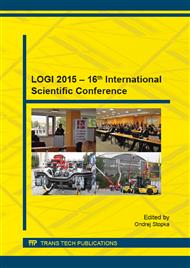[1]
A. David, The Danube inland canals, In: European inland waterway navigation conference [electronic source] = EIWN: 10-11 June 2010, Baja, Hungary, (2010).
Google Scholar
[2]
M. Lednicky, J. Sosedova, German ports on the upper Danube, In: Perner´s Contacts, Vol. 5, No. 1 (2010) 133-141.
Google Scholar
[3]
Manual of Danube navigation, via Donau, Vienna, (2013).
Google Scholar
[4]
Commission regulation (EC) No 414/2007 of 13 March 2007 concerning the technical guidelines for the planning, implementation and operational use of river information services (RIS), (2007).
Google Scholar
[5]
Commission regulation (EC) No 415/2007 of 13 March 2007 concerning the technical specifications for vessel tracking and tracing systems, (2007).
Google Scholar
[6]
Commission regulation (EC) No 416/2007 of 22 March 2007 concerning the technical specifications for Notices to Skippers, (2007).
Google Scholar
[7]
Economic commission of Europe, Guidelines and recommendations for river information services, New York and Geneva, (2005).
Google Scholar
[8]
Directive 2005/44/EC of the European Parliament and of the Council of 7 September 2005 on harmonised river information services (RIS) of inland waterways in the Community, (2005).
Google Scholar
[9]
Information on: http: /www. danubeportal. com.
Google Scholar
[10]
Transport Research Knowledge Centre, River information services – Modernising inland shipping through advanced information technologies, European union, (2010).
Google Scholar
[11]
J. Gnap, et al., Design and Verification of the System for Monitoring Dangerous Goods Shipments within Multimodal Transport in Central and Eastern Europe, University of Zilina in Žilina, Slovak Republic, (2014).
Google Scholar
[12]
B. Holkova, J. Sosedova, Monitoring the transport of goods that are subject to excise tax and tax security, In: Perner´s Contacts, Vol. 8, No. 3 (2013) 170-183.
Google Scholar
[13]
I. Obradovic, M. Milicevic, K. Zubrinic, Machine Learning Approaches to Maritime Anomaly Detection, In: Our sea, Vol. 61, No. 5-6 (2014) 106-116.
Google Scholar
[14]
M. Lednicky, J. Sosedova, Austrian ports on the upper Danube, In: Transport and communications: internet magazine. No. 1 (2010) 149-159.
Google Scholar


